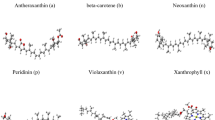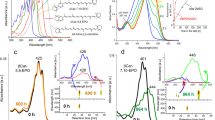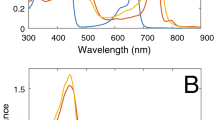Abstract
WE have studied the semiconductive and photoconductive properties of single crystals of β- carotene1. During these and other studies, changes in the electrical conductivity in the presence of oxygen have been observed1,2. The effect of gases on the conductivity of other organic crystals3–8 has indicated that these changes are caused by donor–acceptor interactions between the gas and the crystal. Studies of this type have been largely carried out with anthracene, which is generally regarded as an electron donor, and chloranil, an electron acceptor. β-Carotene, it has been said, should be both a good electron donor and also a good electron acceptor9. These properties of β-carotene are of interest in relation to Platt's theory of the role of β-carotene in the primary photosynthetic process10, and may be relevant to the mechanism of olfaction where it has been proposed that interactions between gas molecules and carotenoids may be involved11–13. Here we present the results of an initial qualitative survey of the effect of various gases and vapours on the conductivity of single crystals of all trans β-carotene.
This is a preview of subscription content, access via your institution
Access options
Subscribe to this journal
Receive 51 print issues and online access
$199.00 per year
only $3.90 per issue
Buy this article
- Purchase on Springer Link
- Instant access to full article PDF
Prices may be subject to local taxes which are calculated during checkout
Similar content being viewed by others
References
Chapman, D., Cherry, R. J., and Morrison, A., Proc. Roy. Soc. A (in the press).
Rosenberg, B., J. Chem. Phys., 34, 812 (1961).
Schneider, W. G., and Waddington, T. C., J. Chem. Phys., 25, 358 (1956).
Waddington, T. C., and Schneider, W. G., Can. J. Chem., 36, 789 (1958).
Labes, M. M., and Rudyj, O. N., J. Amer. Chem. Soc., 85, 2055 (1963).
Reucroft, P. J., Rudyj, O. N., and Labes, M. M., J. Amer. Chem. Soc., 85, 2059 (1963).
Reucroft, P. J., Rudyj, O. N., Salomen, R. E., and Labes, M. M., J. Phys. Chem., 69, 779 (1965).
Reucroft, P. J., Rudyj, O. N., and Labes, M. M., Mol. Cryst., 1, 429 (1966).
Pullman, B., and Pullman, A., in Quantum Biochemistry, 440 (Interscience Publishers, New York, 1963).
Platt, J. R., Science, 129, 372 (1959).
Briggs, M. H., and Duncan, R. B., Nature, 191, 1310 (1961).
Briggs, M. H., and Duncan, R. B., Nature, 195, 1313 (1962).
Dingle, J. T., and Lucy, J. A., Biol. Rev., 40, 422 (1965).
Cherry, R. J., and Chapman, D., Mol. Cryst. (in the press).
Kommandeur, J., in Physics and Chemistry of the Organic Solid State, II, 1 (1962).
Author information
Authors and Affiliations
Rights and permissions
About this article
Cite this article
CHERRY, R., CHAPMAN, D. Effect of Gases on the Electrical Conductivity of β-Carotene. Nature 215, 956–957 (1967). https://doi.org/10.1038/215956b0
Received:
Issue Date:
DOI: https://doi.org/10.1038/215956b0
This article is cited by
-
Mechanism of Olfactory Transduction
Nature (1968)
Comments
By submitting a comment you agree to abide by our Terms and Community Guidelines. If you find something abusive or that does not comply with our terms or guidelines please flag it as inappropriate.



